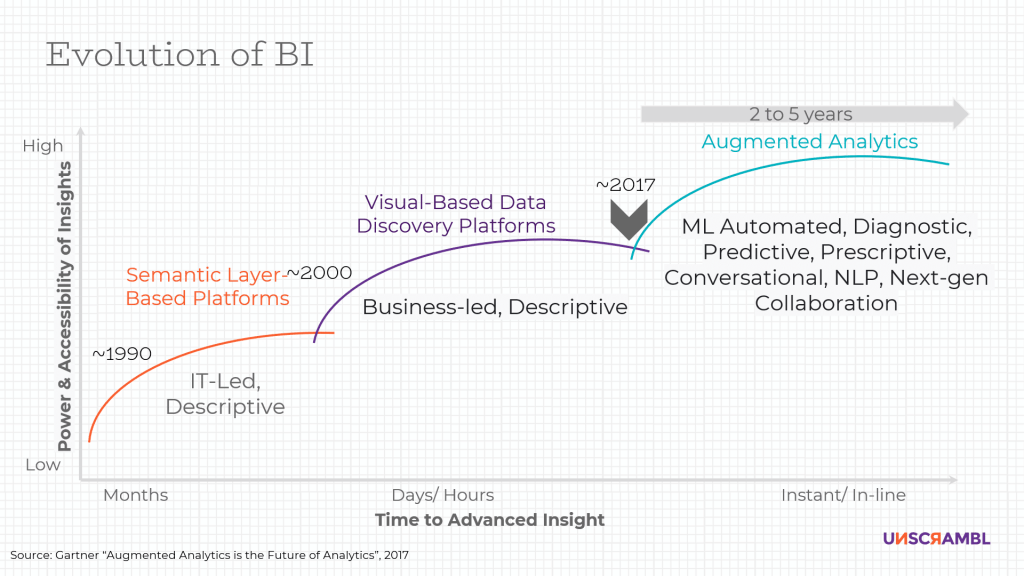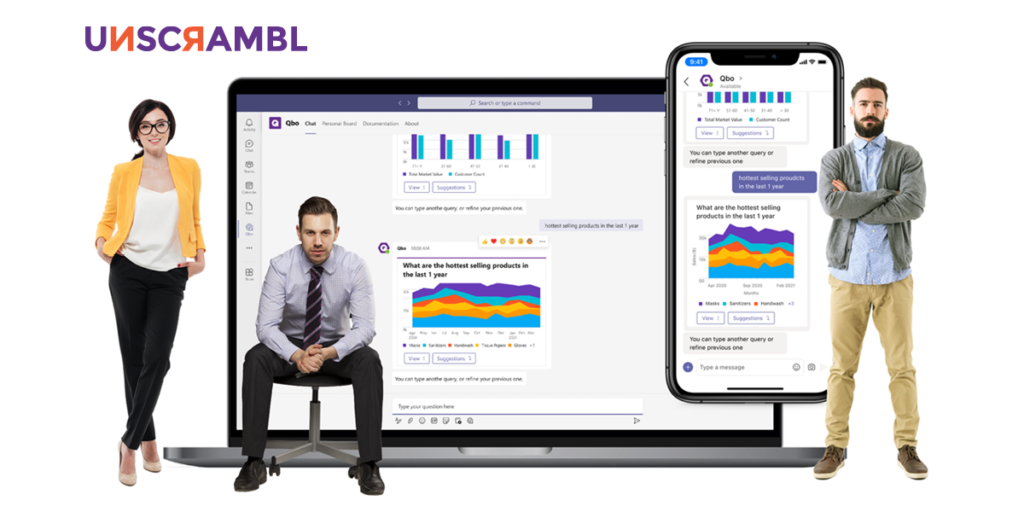 6 Minutes
6 Minutes

The Future of Business Intelligence: Augmented Analytics-driven by AI
Many business leaders and innovators have heard of business intelligence (BI). It is fast evolving into a solution that promises innovation and growth.
But does it really help organizations effectively achieve operational excellence in its current form?
From iconic tech firms such as Uber and Amazon to big corporations including Walmart and JP Morgan, companies are generating enormous amounts of data in their daily operations. Companies are increasingly adopting business intelligence to help uncover insights that will help them drive growth. However, as a whole, business intelligence’s deployment penetration rate is hovering at just 17%.
While data might be the new currency of the modern age, it doesn’t do much good if key employees across an organization don’t fully utilize the BI platform or tools.
For business intelligence to really deliver the promised benefits of innovation and faster data-driven decision making, it will have to be powered by artificial intelligence.
Namely, augmented analytics driven by AI.
But before we can fully appreciate the difficulties of today’s business intelligence tools and the need for its inevitable evolution, let’s take a walk down memory lane on how business intelligence has progressed through time.
The History of Business Intelligence – What You Must Know
Traditional Business Intelligence – the Age of Report Generation
The term ‘business intelligence’ was first conceived in 1958 when IBM researcher Hans Peter Luhn published his paper ‘A Business Intelligence System’.
It covered an idea of an automatic system that will distribute information across an organization’s departments for better communication for better business efficiency.
This was led by the first iterations of business intelligence tools that were developed by companies such as IBM and Oracle.
These included “Extract, Transform & Load” (ETL) tools as well as “Online Analytical Processing” solutions that are still at the heart of today’s business intelligence solution.
Business Intelligence 2.0 – the Era of Self-service BI
From dashboards that provide beautiful visualizations to faster data mining and extraction, today’s BI tools allow non-technical users to gain insights in a self-service kind of way.
This includes tools such as Tableau and Qlik.
Not only do they promote adoption with the promise of customizable dashboards and a more appealing way to digest the data, self-service BI still brings with it significant drawbacks that prevent widespread adoption.
While billions of data points can be swiftly retrieved and analyzed from various points of storage such as the cloud and data warehouses, there exists a knowledge gap in the business users themselves that hinder organizations from enjoying the full benefits of BI
With all the benefits of self-service BI tools, such as the empowerment of non-technical users to gain insights, the drawbacks are significant enough resulting in a rather limited organizational adoption today.
1. There Is Still a Heavy Reliance on IT Departments & Data Analysts
A big part of a business intelligence tool is data governance – the right preparation, storage, and maintenance of data.
While data can be mined and analyzed to deliver insights, the responsibilities of such data preparation still falls onto the laps of IT experts.
Data models will still have to be defined and refined by data analysts before it can be effectively analyzed by the BI tool – this introduces the element of human error, especially if resources in an organization’s IT department are stretched thin.
In fact, while self-service business intelligence features beautiful visualization charts, connecting the dots is still a challenge for leaders to interpret the information – hence the need for continued reliance on an organization’s data experts for assistance.
2. Impactful Insights Are Limited
We are all creatures of habit and once we are used to a routine, we hardly change it up unless we absolutely need to – the same goes with self-service tool’s usage and dashboard set-up.
Yes, more non-technical users can gain the insights that they desire, but if they are constantly searching for the same result, they will be missing the forest for the trees – resulting in analytical cognitive bias.
Dashboards that are set to the same parameters while analyzing the same data-sets to provide reports on the same old variables will only lead to unsurprising results.
And big organizational breakthroughs can only be discovered when users can get the insights they want on-demand in a fluid manner.
3. There Is a Steep Learning Curve Preventing Widespread Adoption
Self-service BI tools are easier for the average user to utilize, but they still need considerable time and training for maximizing their effectiveness.
And in today’s demanding environment where managers are multi-tasking and handling multiple responsibilities, BI tools won’t be fully utilized (and might be totally disregarded) even if they have a self-service element to them.
Convenience is key and to provide this, BI solutions will have to evolve by utilizing the power of artificial intelligence – specifically augmented intelligence.
Enter Augmented Analytics – the Future of Business Intelligence
Imagine a business intelligence solution that assists users with the preparation of data and insights automation, allowing for the discovery of ground-breaking insights that will truly move the needle.
How about a BI tool that allows business users to gain insights on-demand by simply asking a question as they would normally do in a human-to-human conversation?
Through the integration of augmented intelligence, machine learning, and natural language processing, the next generation of business intelligence will transform how companies interact with their data.
In fact, according to Gartner, augmented intelligence is poised to create $2.9 trillion worth of business value in 2021.
4 Ways Augmented Analytics Will Revolutionize Business Intelligence
1. Data Clean-up & Preparation Will Be Handled by Artificial Intelligence
One of the most labor-intensive steps of utilizing BI tools today is the need to accurately clean up data as well as selecting the right data-sets and dimensions to be analyzed.
This task will inevitably be handled by data analysts, causing delays in the workflow. And for organizations without the luxury of a robust IT department, using BI tools might not even be feasible for them.
Thankfully with augmented analytics, artificial intelligence will be connecting and processing data that is spread across databases in organizations autonomously, allowing for seamless analysis.
This helps to reduce the over-reliance on your IT departments which is probably over-taxed.
2. More Accurate Insights Will Be Delivered
Through machine learning, augmented analytics will help to better identify patterns, trends, and connections between your datasets.
Not only will a direct analysis be done on your query, but machine learning allows for comprehensive analysis on all possible data combinations and interconnections – fostering an automated ecosystem of data collaboration.
This will help deliver a higher level of accuracy in your insights that you can rely upon for true data-driven decision making.
3. Delivering Automated Insights & Alerts
Getting insights on-demand is great, but getting them preemptively through alerts is even better.
Augmented analytics can independently analyze an organization’s datasets and quickly understand the metrics and KPIs that are important to the company and related departments.
These automated insights will help business leaders quickly identify opportunities in real-time as they are happening to gain a competitive edge in an ever-changing commercial landscape.
4. Easier Adoption by Simply ‘talking to Their Data’
Perhaps the most impressive benefit of augmented analytics is the ability to get everyone across an organization involved in business intelligence.
One of the main barriers to widespread BI adoption is the ease of use – and many business leaders just don’t have the time to learn to effectively analyze their data.
Through the power of conversational analytics, driven by natural language processing, users can ‘talk’ to their data as they would in a normal conversation.
Looking to better understand the financial state of your business?
A user will just have to ask a question such as “What is my sales revenue over the last 12 months?”
Deeper and more insightful questions can also be asked such as “Which of our retail stores generated the most profit this financial year and how much of an increase was it compared to the previous year?”
This allows for leaders from various departments to immediately gain insight into their data without overwhelming themselves or requiring any extensive learning on how to operate the BI tool.
Augmented Analytics Goes Beyond Delivering Insights – It Helps to Foster a Data-driven Culture
While we all believe that all business decisions are made logically and backed-up by data, it just really isn’t so.
A huge amount of it is done through gut feelings and a measure of guess-work sprinkled with some insights from data – we can all agree that this is far from ideal!
With augmented analytics, wider adoption of BI tools will be possible throughout the ranks of an organization. This allows for more frequent data-driven decision making just due to the ease of doing so.
From the data scientists to the employees on the front-lines, departments will be able to gain insight easily on issues and challenges that matter to them. This helps to promote collaboration between teams and promote data democratization throughout an organization.
Augmented analytics allows for the creation of an effective data-driven culture and only through this can the full benefits of business intelligence be truly realized.
Embrace a Data-driven Culture Today
As businesses grow, operations between departments get more interconnected and complex.
Coupled with a need to maximize time and make faster data-driven decisions, companies will need to go beyond self-service BI tools to take their decision-making to the next level.
Augmented analytics is the solution that will change how each individual user experiences business intelligence and move organizations towards greater adoption across work teams.
Thankfully, the future of BI is here and the wait is over.
With Qbo, businesses can experience the full potential of augmented intelligence and gain insights on-demand by simply asking questions.
Try it for yourself. Embark on a free 14-days trial and discover how intuitive business intelligence can be.
The era of data democratization has begun.




